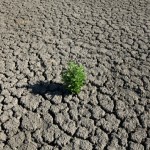The Texas Drought, As Seen from Space (Things Don’t Look Good)
A drought is a strange type of disaster. While hurricanes, tornadoes and floods do their damage quickly and dramatically, drought is like a slow death, a drying out of life and land. A house can be rebuilt after a flood recedes, but with a drought all you can do is wait for rain. And wait.
We may have to wait a little longer. A new NASA map shows that groundwater and soil moisture levels in Texas are at their “lowest levels seen in more than 60 years.” The maps show a large, maroon crescent over much of the populated regions of Texas (the line almost seems to mirror the I-35 Interstate at a glance).
This wide swath across Texas indicates “severely depressed groundwater levels,” according to NASA, and “shows that the level of dryness over the last week [has] occurred less than two percent of the time between 1948 and the present.” The months since the drought began have been the driest on the books since record keeping in Texas began in 1895 – an average of only 11.1 inches of rain.
Is there an end in sight? “Texas groundwater will take months or longer to recharge,” Matt Rodell, a hydrologist at NASA’s Goddard Space Flight Center in Maryland, said in NASA’s report. “Even if we have a major rainfall event, most of the water runs off,” he said. “It takes a longer period of sustained greater-than-average precipitation to recharge aquifers significantly.”
Though there was some good news this week with the release of the latest state drought monitor report. The numbers show that recent rains have helped ease the situation somewhat, with 52 percent of the state in the “exceptional” drought state, compared to 81 percent three months ago. But 82 percent of the state remains in “extreme” drought:
The current drought “has been the most intense one-year drought in Texas since at least 1895 when statewide weather records begin,” state climatologist John Nielsen-Gammon reported to lawmakers recently, “and… it probably already ranks among the five worst droughts overall.”
“Over a long-term dry period there will be an effect on groundwater storage and groundwater levels,” Rodell said in the NASA report. “It’s going to drop quite a bit, people’s wells could dry out, and it takes time to recover.”
As Kate Galbraith reported this week in the Texas Tribune, that recovery time could be a way off yet:The main cause of the drought, the most intense in recorded Texas history, is back-to-back episodes of La Niña, a Pacific Ocean phenomenon that almost always brings dry conditions to the state. The bad news is that, based on the historical record, there is a 40 percent chance of La Niña returning for a third consecutive year, according to Klaus Wolter, a research associate with the Earth Research Laboratory at the National Oceanic and Atmospheric Administration (NOAA).
Galbraith notes that there have been ten times during the last century where La Niña has occurred twice in a row, but that this is a limited set of data. “Here’s the good news,” Galbraith writes, “the other six times, an El Niño has followed the two La Niñas, bringing unusually wet weather.
“Whether the drought will end after two years or last three years or beyond is impossible to predict with any certainty,” the state climatologist reported recently, “but what is known is that Texas is in a period of enhanced drought susceptibility due to global ocean temperature patterns and has been since at least the year 2000.”
So if we get an El Niño next year, the drought would likely end. But we probably won’t know until June.





